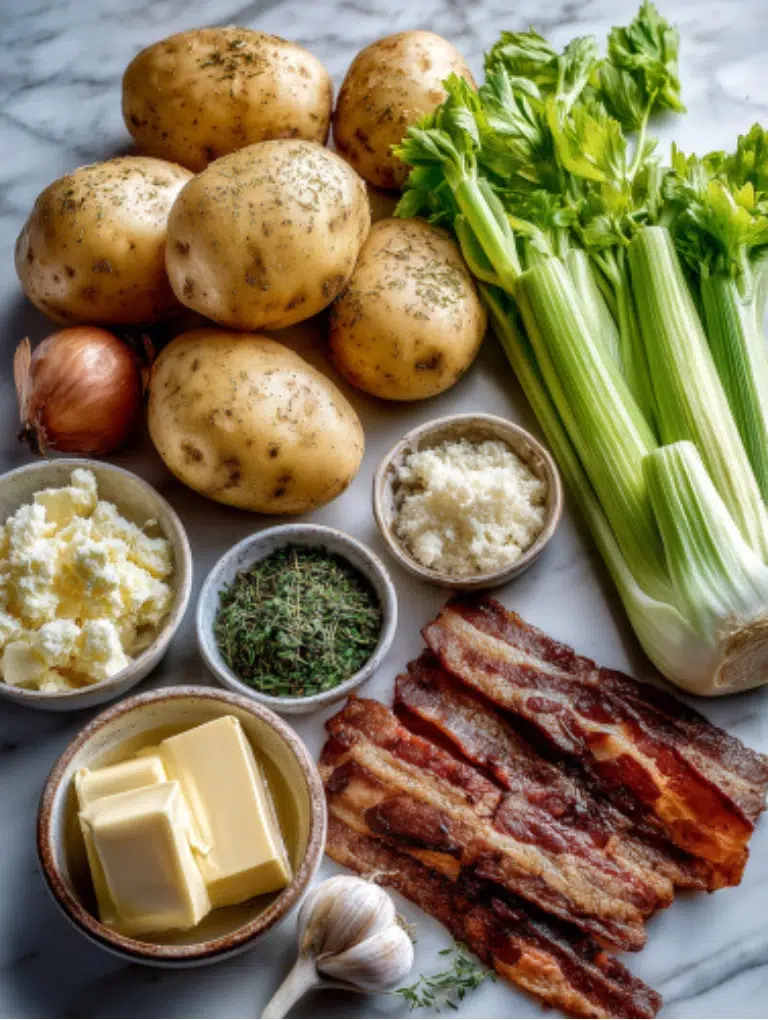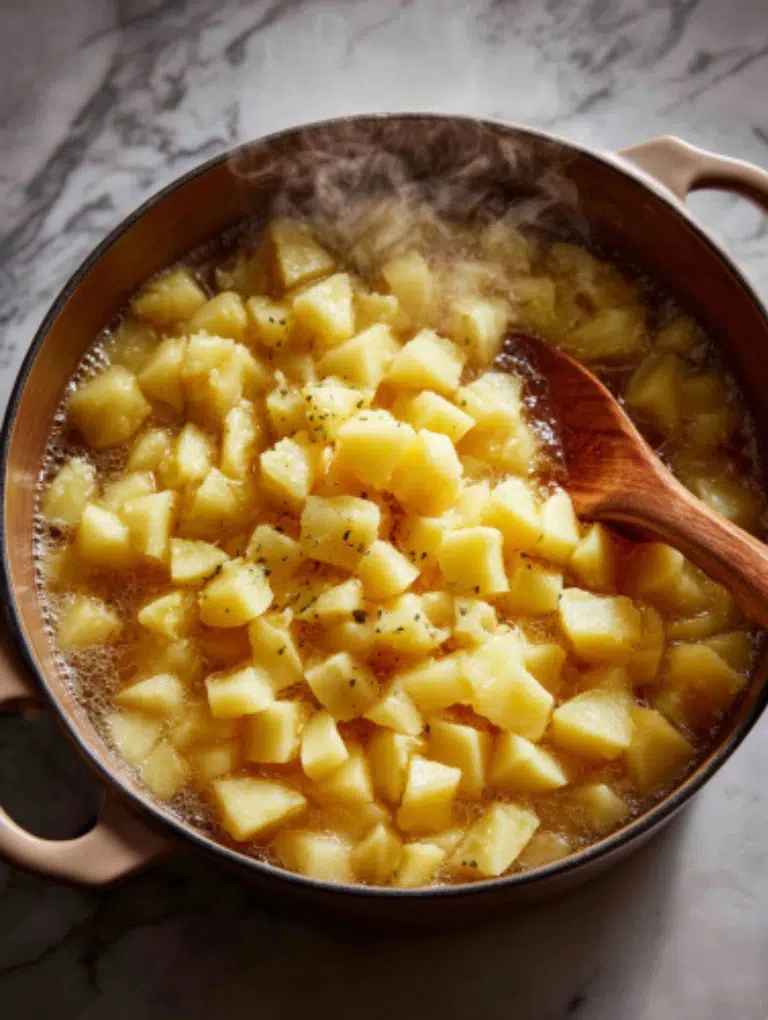Nothing beats a warm bowl of potato soup on a chilly evening. This creamy classic brings together tender potatoes, smoky bacon, and a rich, velvety broth that feels like comfort in a bowl. Whether you’re feeding your family on a weeknight or looking for a cozy dish to share with friends, this recipe makes it simple. With straightforward steps and everyday ingredients, you’ll end up with a satisfying soup that tastes like it simmered all day.
Table of Contents
Why You’ll Love This Potato Soup Recipe
- Quick and easy: From stovetop to table in about an hour.
- Simple ingredients: Uses potatoes, broth, and a few kitchen staples you likely already have.
- Rich, creamy texture: Perfectly thickened without feeling heavy.
- Customizable toppings: Add bacon, cheddar, chives, or keep it plain and cozy.
- Comfort food at its best: Ideal for family dinners, potlucks, or a quiet night in.
Unlike many versions, this soup balances a velvety base with chunks of tender potatoes for the best of both worlds. It is hearty enough to stand alone but versatile enough to pair with pumpkin pasta for a cozy fall dinner or a crisp salad. One spoonful will remind you why potato soup has remained a timeless favorite for generations.
Ingredients Needed

Core Ingredients
- 1 pound bacon, chopped: adds smoky flavor and richness.
- 2 stalks celery, diced: brings subtle freshness.
- 1 medium onion, chopped: builds the flavor base.
- 3 cloves garlic, minced: deepens the savory notes.
- 8 medium potatoes, peeled and cubed: Yukon Golds give a creamier finish, russets create a fluffier texture.
- 4 cups chicken stock (or enough to cover potatoes): vegetable stock works for a vegetarian version.
- 3 tablespoons butter: for the roux.
- 1/4 cup all-purpose flour: thickens the soup.
- 1 cup heavy cream: creates the velvety texture.
- 1 teaspoon dried tarragon: adds a hint of sweetness.
- 3 teaspoons chopped fresh cilantro: brightens the finish.
- Salt and freshly ground black pepper: season to taste.
Notes & Substitutions
- Gluten-free: swap flour with cornstarch or potato starch.
- Dairy-free: use olive oil instead of butter, and coconut milk or cashew cream instead of heavy cream.
- Budget-friendly: skip the bacon and add smoked paprika for a similar depth.
- Herb swap: parsley or chives work well if you don’t like cilantro.
How to Make Potato Soup
Step 1: Cook the bacon
Place chopped bacon in a large pot or Dutch oven. Cook over medium heat until crispy, 5–10 minutes. Transfer bacon to a paper towel-lined plate. Leave about 1/4 cup of the drippings in the pot for flavor.
Step 2: Build the flavor base
Add diced celery and onion to the drippings. Sauté until the onion softens, about 5 minutes. Stir in garlic and cook 1–2 minutes until fragrant. This step lays down the soup’s savory foundation.
Step 3: Cook the potatoes
Add the cubed potatoes, toss to coat, and sauté for 3–4 minutes. Return the bacon to the pot. Pour in enough chicken stock to just cover the potatoes. Bring to a simmer, cover, and cook until tender, 15–20 minutes.
Step 4: Make the creamy roux
In a separate skillet, melt the butter. Whisk in the flour and cook for 1–2 minutes to remove the raw flour taste. Slowly whisk in the heavy cream, tarragon, and cilantro. Cook until slightly thickened, about 5 minutes.
Step 5: Combine and blend
Stir the cream mixture into the pot of potatoes. Blend about half the soup with an immersion blender (or carefully with a countertop blender) until smooth, leaving some chunks for texture.
Step 6: Season and serve
Taste and adjust with salt and pepper. Ladle into bowls and serve hot with your choice of toppings like shredded cheddar, extra bacon, or fresh chives.

Pro Tips & Troubleshooting
Expert Tips
- Choose the right potato: Yukon Golds give a creamy, buttery texture, while russets create a fluffier, lighter soup.
- Blend wisely: Puree only half the soup to keep a balance of smooth base and chunky bites.
- Layer flavors: Sauté onions and garlic slowly for depth, and add fresh herbs just before serving for brightness.
- Finish with dairy off-heat: Stir in cream after removing from direct heat to avoid curdling.
Common Mistakes to Avoid
- Over-blending: Blend gently, since vigorous mixing can rupture potato starch granules and turn the texture pasty, as Exploratorium explains.
- Skipping the roux: Without the butter-flour base, the soup can turn thin and watery.
- Over-salting early: Bacon and stock both add salt, so season only after the soup is fully cooked.
- Adding dairy too soon: Boiling cream can cause separation.
Creative Shortcut
If you’re short on time, skip making a roux and instead mash a few cooked potatoes right in the pot. It thickens the soup naturally while keeping the flavor hearty.
Serving, Storage & Variations
Serving Ideas
- Top each bowl with crispy bacon, shredded cheddar, and fresh chives.
- Add a dollop of sour cream or Greek yogurt for tang, and offer a square of cheesy meat potato on the side for a weekend spread.
- Pair with warm pumpkin bread, biscuits, or a side salad for a complete meal.
Storage Guidelines
Refrigerate leftovers for 3 to 4 days and freeze for best quality 3 to 4 months, then thaw safely in the refrigerator, according to USDA FSIS. When freezing, expect dairy-based soups to separate slightly when thawed and reheated, a common effect K-State Extension describes, which you can often fix by whisking in a little milk or cream.
Reheating Methods
- Stovetop: Warm gently over medium heat, stirring often. Add a splash of milk or stock if it thickens too much.
- Microwave: Heat in 1–2 minute intervals, stirring between rounds for even warming.
Thaw soup in the refrigerator and reheat gently, keeping food out of the 40–140°F danger zone, as UMN Extension advises.
Recipe Variations
- Loaded style: Add extra cheese, bacon, and scallions.
- Baked potato twist: Stir in sour cream and top with baked potato toppings.
- Vegan version: Use olive oil instead of butter, veggie broth instead of chicken stock, and cashew cream in place of dairy.
- Spicy kick: Mix in a pinch of cayenne or top with jalapeños.

Nutritional Information
Per Serving (approximate)
| Nutrient | Amount |
|---|---|
| Calories | 594 |
| Fat | 42 g |
| Carbohydrates | 44 g |
| Protein | 13 g |
| Fiber | 5 g |
| Sodium | 879 mg |
| Vitamin C | 44 mg |
| Calcium | 66 mg |
| Iron | 2 mg |
| Potassium | 1106 mg |
Nutrition Notes
- Potatoes are a good source of potassium and vitamin C, as the USDA Agricultural Research Service notes.
- Bacon and cream increase fat and sodium, making the soup rich and hearty.
- For a lighter bowl, use half-and-half or milk instead of heavy cream, and reduce bacon or swap with smoked paprika.
- To increase protein, stir in shredded chicken or top with Greek yogurt.
Tip: Use tools like Cronometer or MyFitnessPal to recalculate values if you adjust ingredients.
Conclusion
Potato soup is the kind of meal that feels like home in every bite. With its creamy base, tender chunks of potato, and savory layers of flavor, this recipe is proof that simple ingredients can deliver something extraordinary. It’s easy to make, flexible to adjust, and always satisfying no matter the occasion.
Whether you serve it with honey garlic chicken breasts for a protein boost, as a cozy weekend meal, or as a starter for a bigger gathering, this soup always wins over the table. Add your favorite toppings, try a variation or two, and make it your own.
If you try this potato soup, leave a comment below and share your star rating. Did you add a twist or swap an ingredient? Let us know. And don’t forget to share this recipe with friends or save it on Pinterest so you can come back to it whenever comfort food calls.
Frequently Asked Questions (FAQ)
What are the best potatoes for potato soup, Yukon Gold or russet?
Yukon Gold potatoes create a naturally creamy, buttery soup. Russets break down more, giving a lighter but fluffier texture. Both work, but the choice depends on whether you want silky or hearty.
How do I thicken potato soup without flour or cornstarch?
Mash a few cooked potatoes directly in the pot or blend a portion of the soup. This adds natural starch that thickens without extra ingredients.
Can I freeze potato soup and how should I reheat it later?
Yes, but cool it first. Freeze in airtight containers for up to 2 months. Thaw overnight in the fridge, then reheat gently on the stove with a splash of milk or broth.
How do I keep potato soup from turning gluey when I blend it?
Avoid over-blending, especially with a high-speed blender. Stick with an immersion blender or mash by hand for a rustic finish.
What dairy-free swaps work best for a creamy result?
Use olive oil or vegan butter in place of butter, and try coconut milk, cashew cream, or unsweetened almond milk instead of heavy cream.
Can I make this in a slow cooker or Instant Pot, and what are the cook times?
Yes. In a slow cooker, cook on low for 6–7 hours or high for 3–4 hours. In an Instant Pot, cook on high pressure for about 10 minutes with natural release.
How do I fix potato soup that tastes bland or too salty?
For bland soup, add extra garlic, fresh herbs, or a squeeze of lemon. If it’s too salty, stir in a splash of cream or add a peeled potato to absorb excess salt while simmering.















